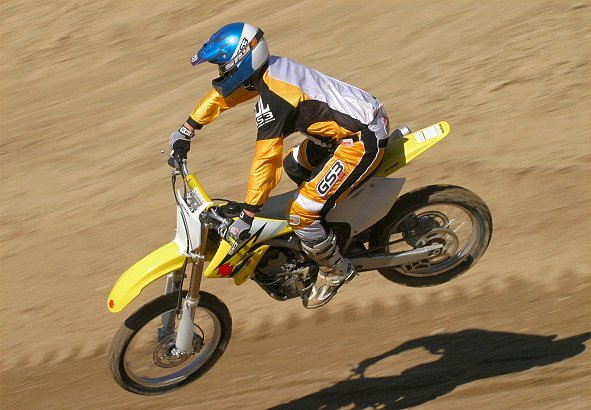
Suzuki invited MD and a number of other journalists to Glen Helen Raceway here in Southern California to sample the new RM-Z250 motocrosser jointly developed with Kawasaki. This is our first ride impression.
Technical details of the bike are identical to those of the Kawasaki KX250F described in our earlier article here. Since Suzuki was more closely involved in the development of the engine (indeed, Suzuki claims responsibility for development of the engine), we would like to discuss some additionally technical details about the motor.
It is safe to say that Suzuki threw everything it had at this engine design, and it has plenty (witness the success of their four-stroke street bikes, such as the dominant GSX-R1000). Extremely over-square, with a 77mm x 53.6mm bore and stroke, the engine features what Suzuki refers to as SASS (Suzuki Advanced Sump System), which permits the crankshaft to be positioned lower in the crank cases. Together with vertically-staggered transmission shafts, the engine is shorter front-to-rear, with a lower center of gravity.
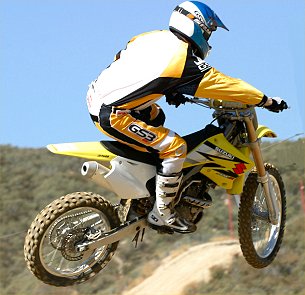
Liberal use of magnesium and thin-wall aluminum castings, together with extremely light engine internals (remember that sportbike engine building experience?) leaves the engine very light, as well. Indeed, Suzuki claims that the engine powering the RM-Z250 is the “lightest, most compact, most powerful four-stroke motocross engine of its size ever put into mass production.” A pretty big claim given the competition in this class, but, regarding the weight claim, at least, believable, nonetheless. Believable, because the steel frame configuration (a Kawasaki-style perimeter design), while being very slender, strong and stiff, is not known for being one of the lightest frame designs, yet, according to one magazine that had thrown all four bikes in this 250cc four-stroke motocross class on the scale, this machine ties for the lightest in the class (tieing the Honda CRF250R, with its aluminum frame, at 216.5 pounds). Pretty light, and pretty amazing considering the frame construction. Credit a very light engine, in part.
Okay, so the engine is extremely light, compact and carries its weight low in the frame. All good things, really. What about power?
Suzuki knows how to make power from a four-stroke engine, as we pointed out earlier, and that over-square design is part of the equation. A relatively high compression ratio of 12.6:1 is another part, as are large valves set at a narrow, included valve angle. The design of these titanium valves borrows know-how from the GSX-R line of four-stroke sportbikes, as does the cam timing and lift.
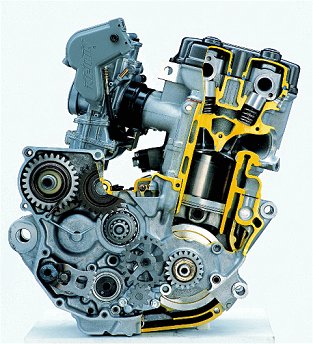
The result is a powerful engine, with a broad spread of torque. Suzuki claims maximum power is achieved at 11,000 rpm, and maximum torque at 8,500 rpm. Suzuki also claims peak horsepower of 42.1 and peak torque of 21.2 foot pounds, both measured at the crank.
As we said, for additional discussion of engine and chassis specifications refer back to our earlier article here.
Now for the ride review.
Since the Suzuki and Kawasaki are essentially the same bikes, our ride review conclusions should be the same. The only difference, and it is a significant one, concerns the location of the ride (Glen Helen versus Cahuilla Creek). Cahuilla Creek is at significantly higher elevation, has loamier, heavier dirt (which was wet at the time) and, we believe the atmospheric conditions contributed to the Kawasaki running a bit rich.
The bottom line is that the Suzuki felt a bit punchier, and stronger, in the engine department at Glen Helen than the Kawasaki had at Cahuilla Creek. At least one journalist has reported that Suzuki leaned out the carburetion from the stock settings. We had mentioned to one of the Kawasaki representatives (at our Cahuilla Creek KX test) that we thought the bike was running a bit rich, but sensed some reluctance to drop the carburetor needle one notch (our suggestion). Nevertheless, the Suzuki seemed to pull a bit stronger and longer at Glen Helen. Again, these are identical motorcycles so it had to be atmospheric conditions, track conditions and carburetor jetting creating the perceived differences.
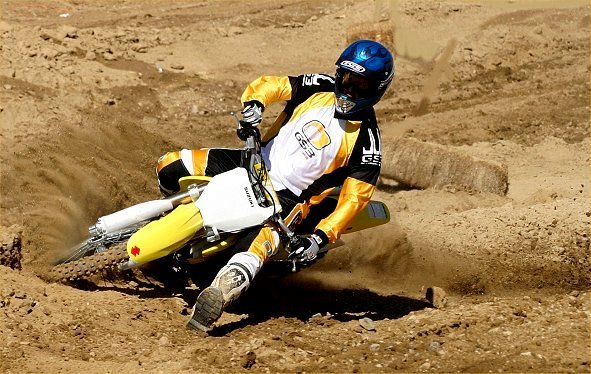
Glen Helen has a number of steep hills, tight corners and short straightaways. A layout that really gives you a test for the torque characteristics of the motorcycle. The RM-Z250 pulled test rider Russ Sommers (who packs well over 200 pounds on his 6’3″ frame) around quite well. As you might expect, the torque compared to a 125cc two-stroke is monstrous. The RM had no problem launching Russ up hills and out of tight corners with authority.
The handling characteristics were just as impressive as the Kawasaki’s. The bike inspires a lot of confidence with good stability on rough straights, while having the ability to carve corners with little effort.
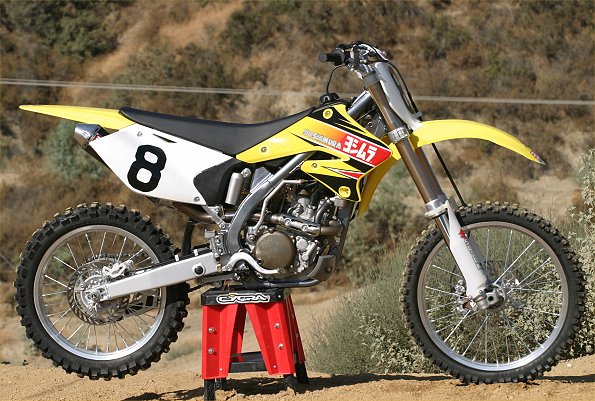
Suzuki had a Yoshimura-modified RM-Z250 on display — Note the custom graphics and prototype Yoshimura pipe
Although the stock spring rates are too light for Russ (he is both big and fast), adjusting preload on the rear shock allowed Russ to push the bike during our test. The spring rates are probably more suited, however, to riders in the 140-180 pound range. Stiffer or lighter springs will make the suspension work well for any rider, however. What is most important is that the valving felt good, and, even with Russ’ weight, bottoming is not a significant issue.
The five-speed transmission worked flawlessly (no missed shifts and relatively low effort shifting). Along with the clean throttle response (again, we thought the bike was jetted a little bit cleaner), the RM-Z250 felt like a potent weapon. Stay tuned for more information following more extensive testing.





